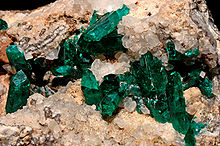- Dioptase
-
Dioptase 
Dioptase from Altyn Tübe, Kazakhstan, the type localityGeneral Category Silicate mineral Chemical formula CuSiO3·H2O Crystal symmetry Trigonal 3 Rhombohedral Unit cell a = 14.566 Å, c = 7.778 Å; Z = 18 Identification Color Dark blue green, emerald green Crystal habit Six sided prisms terminated by rhombohedrons to massive Crystal system Trigonal Cleavage Perfect in three directions Fracture Conchoidal Tenacity Brittle Mohs scale hardness 5 Luster Vitreous Streak Green Diaphaneity Transparent to translucent Specific gravity 3.28–3.35 Optical properties Uniaxial (+) Refractive index nω = 1.652 - 1.658 nε = 1.704 - 1.710 Birefringence δ = 0.052 References [1][2] Dioptase is an intense emerald-green to bluish-green copper cyclosilicate mineral. It is transparent to translucent. Its luster is vitreous to sub-adamantine. Its formula is CuSiO3·H2O (also reported as CuSiO2(OH)2). It has a hardness of 5, the same as tooth enamel. Its specific gravity is 3.28–3.35, and it has two perfect and one very good cleavage directions. Additionally, dioptase is very fragile and specimens must be handled with great care. It is a trigonal mineral, forming 6-sided crystals that are terminated by rhombohedra.
Contents
History
Late in the 18th century, copper miners at the Altyn-Tyube (Altyn-Tube) mine, Karagandy Province, Kazakhstan[2] thought they found the emerald deposit of their dreams. They found fantastic cavities in quartz veins in a limestone, filled with thousands of lustrous emerald-green transparent crystals. The crystals were dispatched to Moscow, Russia for analysis. However the mineral's inferior hardness of 5 compared with emerald's greater hardness of 8 easily distinguished it. Later Fr. René Just Haüy (the famed French mineralogist) in 1797 determined that the enigmatic Altyn-Tyube mineral was new to science and named it dioptase (Greek, dia, "through" and optima, "vision"), alluding to the mineral's two cleavage directions that are visible inside unbroken crystals.
Occurrence
Dioptase is an uncommon mineral found mostly in desert regions where it forms as a secondary mineral in the oxidized zone of copper sulfide mineral deposits. However, the process of its formation is not simple, the oxidation of copper sulfides should be insufficient to crystallize dioptase as silica is normally minutely soluble in water except at highly alkaline pH. The oxidation of sulfides will generate highly acidic fluids rich in sulfuric acid that should suppress silica solubility. However, in dry climates and with enough time, especially in areas of a mineral deposit where acids are buffered by carbonate, minute quantities of silica may react with dissolved copper forming dioptase and chrysocolla.
The Altyn Tube mine in Kazakhstan still provides handsome specimens; a brownish quartzite host distinguishes its specimens from other localities. The finest specimens of all were found at the Tsumeb Mine in Tsumeb, Namibia. Tsumeb dioptase is wonderfully lustrous and transparent, with its crystal often perched on an attractive snow-white carbonate matrix. Dioptase is also found in the deserts of the southwestern USA. A notable occurrence is the old Mammoth-Saint Anthony Mine near Mammoth, Arizona where small crystals that make fine micromount specimens are found. In addition, many small, pale-green colored crystals of dioptase have come from the Christmas Mine near Hayden, Arizona. Another classic locality for fine specimens is Renéville, Congo-Brazzaville. Finally, an interesting occurrence is the Malpaso Quarry in Argentina. Here tiny bluish-green dioptase is found on and in quartz. It appears at this occurrence, dioptase is primary and has crystallized with quartz, native copper, and malachite.
 Dioptase crystals from Democratic Republic of the Congo, displaying the dioptase crystal habit of six sided prisms terminated by rhombohedrons
Dioptase crystals from Democratic Republic of the Congo, displaying the dioptase crystal habit of six sided prisms terminated by rhombohedrons
Use
Dioptase is popular with mineral collectors and it is occasionally cut into small emerald-like gems. Dioptase and chrysocolla are the only relatively common copper silicate minerals. A dioptase gemstone should never be exposed to ultrasonic cleaning or the fragile gem will shatter. As a ground pigment, dioptase can be used in painting.
See also
References
- Hurlbut, Cornelius S.; Klein, Cornelis, 1985, Manual of Mineralogy, 20th ed., ISBN 0-471-80580-7
Categories:- Gemstones
- Copper minerals
- Cyclosilicates
- Trigonal minerals
Wikimedia Foundation. 2010.

